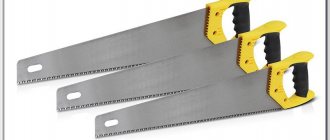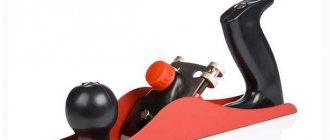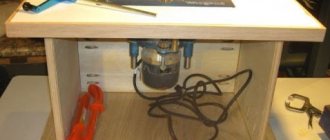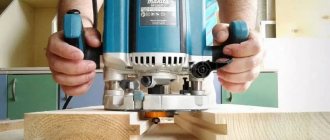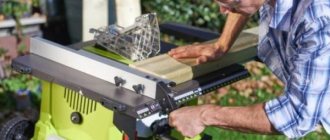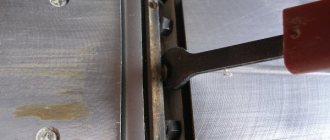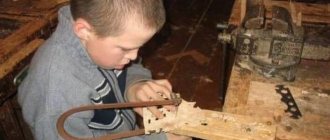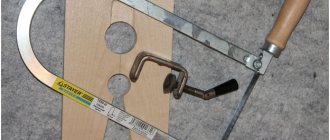If working with wood is your hobby, then it will be useful to know how to choose a manual wood router for your home. Since this is a multifunctional device, in order to understand how to work with it, you need to familiarize yourself with its basic parameters and additional characteristics, as well as functions that are not required but can be very useful. Let's consider all these points in more detail, plus the main types of models and their ratings.
Hand router Source www.bosch-do-it.de
Why do you need a router?
A wood milling machine is a tool that allows you to make cuts, grooves, cut out joints, and also remove a thin layer of material. This tool is used in carpentry, when constructing furniture and when working with parquet or laminate. With its help, you can make longitudinal edges, complex patterns, tenon joints, and also cut grooves for dowels and dowels.
Why you need a router can be understood if you understand its varieties and structure, as this will help you choose the necessary tool.
Circular groove Source m-stone.ru
Types of router
To choose which hand router is suitable for a given purpose or intended for universal use, you should familiarize yourself with the manufacturing options of this tool and what each of them is used for.
Types of attachments Source perego-shop.ru
Rod
The submersible model has a body that is mounted on a special rod, along which it can move vertically. A support mechanism is attached to the bottom of the guide. The entire unit is placed on it and, using the side handles that need to be pressed, it is immersed in the material.
After finishing the work, release the handles and the router will rise up under the pressure of the springs. It can be used to make grooves, cutouts, holes or joints, as well as curly patterns. Due to its high functionality, this model is considered universal, but the increased weight does not allow it to work well in vertical areas. Working with a router for beginners with this tool will be simpler and more understandable.
Tool with immersion mechanism Source i.allo.ua
Edging
An edge tool (trimmer) is capable of working not only on horizontal surfaces, but also on vertical ones. Most often it is small in size, so it can be used with one hand. The body itself has a narrowing and a special rubberized coating. This is necessary to use it as a handle.
The bottom of the device has a sliding surface to prevent scratches and also for smoother movement. The immersion depth of the cutter is changed using a special scale. With this tool you can use additional attachments: a rip fence - for processing the edges of a part or corners, as well as a copying sleeve, which allows you to make cuts according to a template.
Using this tool, you can process laminated or veneered parts, select grooves, round corners, fit blanks, and make shallow cutouts for decoration. The trimmer is recommended for use in workshops that require daily edging work.
Edging router Source www.rucne-naradie.sk
Lamellar
The body of such a tool has a horizontal body and is similar in design to a grinder. At the bottom it has a mechanism for operation, and a wide handle is attached above it. This model is equipped with a disk cutter for cutting into wood. To work, you need to press the tool on the material to immerse the cutter inside. Thus, you can make a special groove for attaching oval parts (lamellas).
It is recommended to work with a manual router of this type for making grooves or trimming parts. This machine is not suitable for rare use, since its purchase will not pay for itself. Therefore, you should choose such a model for frequent use in workshops for which it is needed every day.
Lamellar router Source laukar.com
Additive
This type of milling tool is similar in shape and design to a lamellar one, but there is a significant difference in its mechanism. To operate, this model uses 2 spiral cutters that work on the principle of a drill. With their help, an accurate connection of parts is made, since they cut into the material at a certain distance from each other. When immersed, the tips cut grooves into which dowels can be installed.
This type of tool is used in furniture production to connect parts whose fastening areas need to be made invisible. The cutter for this tool can be dowel or dowel. With their help, you can make holes for detachable and non-demountable connections.
Filler milling machine Source harrer.at
Rotary
This type of tool is similar in operating principle to a rod tool, but has a smaller size and a narrowed body, like an edging tool. It can be used for woodworking or ceramic tile work. It is also capable of processing plasterboard floors, chipboard, plastic and soft types of metal. Its speed reaches 30 thousand per minute, which makes it possible to work with hard materials.
The small size of the device makes it possible to work with a manual wood router using one hand, since its weight is small. When replacing a cutter, you can install a diamond rod or a cutter for working with ceramics. Using this type of tool, if it is equipped with speed control, work is performed on materials of varying densities, for example, cutting holes or processing edges.
Rotary router Source allegroimg.com
Main features of the router
Despite the fact that this device seems to be very complicated, in fact, the router is considered one of the simplest electrical devices.
Unlike other devices, here the equipment is attached directly to the electric motor shaft (spindle), so the machine is free of the presence of a gearbox, belts, and gears. The power unit (head) of this tool can have quite a lot of power, which can be compared with stationary equipment, but all manufacturers place the main emphasis on the high speed of the cutter ; direct transmission makes it possible to accelerate the machine head to impressive speeds.
The unit can be equipped with many additional devices designed for productive sampling and accurate feeding:
- clamps;
- all kinds of stops;
- templates;
- guides, etc.
And it is the functionality of these auxiliary devices that places the most stringent requirements.
Not only wood can be used with a router; without any problems (installation requires equipment), you can work with non-ferrous metals, plastics, composites, plexiglass , artificial stone, and so on. Taking into account some design features and purposes, there are several types of milling cutters:
- Rod
- Fixed.
- Kromočny.
- Specialized.
The most popular and versatile is the plunge-cutting rod milling machine . In this case, the cutter of the device moves along guide rods rigidly connected to the base of the support.
Thus, the cutter is clearly in a vertical position and smoothly plunges into the workpiece to a set depth until the upper moving part touches the adjustable stop. The operator then moves the machine in a horizontal position , and the main work is done by the sharp edges of the rotating cutter.
Builders, finishers, carpenters and furniture makers have appreciated the advantages of the tool and would never give up this assistant for anything. The specialization of a milling machine can hardly be called extensive, but many of the operations that it can perform may seem unusual.
We list only the main ones:
- straight or figured profiling of edges (stair tread, table top);
- quarter sample;
- production of longitudinal and spiral/twisted grooves on conical and cylindrical parts (balusters, legs);
- drilling holes, including dowels;
- engraving, decorative wood carving (on a plane - fresco or volumetric - sculpture);
- rough grinding;
- flush fitting of laminates in furniture;
- making slots, folds, grooves (for fastening furniture elements together);
- cutting out seats (for door locks and fittings, corners, canopies);
- rough alignment of edges, cutting work (creation of a workpiece);
- performing bindings (fastening perpendicular parts of doors and windows);
- cutting different shapes of tenons for splicing/fastening parts.
Main characteristics
Working with a milling cutter largely depends on the characteristics of the tool. The weight of the device is directly related to its power, since the more power there is, the heavier and larger the motor inside the case. The maximum size and length of the cutter also depends on the engine power. It also gives rise to the classification of tools by size:
- a device weighing 2-3 kg and a motor of 420 - 750 W is considered light;
- a medium-sized milling cutter has a power from 800 to 1450 W and a weight of up to 5 kg;
- a tool is considered heavy if it has a 1500-2300 W motor installed and its weight starts from 6 kg.
Professionals give advice for dummies on how to choose a manual wood router for the home, after analyzing the volume and complexity of the work. Beginners should opt for a lightweight instrument, as it is easier to learn.
Small device Source cdnmedia.220-volt.ru
Its heating speed also depends on the power of the device: the weaker the engine, the faster it heats up. Therefore, to make deep cuts or frequent milling, you should use a tool that has a motor of 1500 W or more installed.
If there is a choice of models whose power differs by no more than 200 W, then you should choose the one with the maximum power, since it will be able to work under the same loads and not overheat.
One of the important parameters for working with a milling cutter on wood or hard material is the number of revolutions it makes in 1 minute. (rpm). Most often, the device has a function for changing the speed, since in its absence it will become less universal and will not be suitable for all materials.
To operate, the milling cutter can use speeds from 3 to 35 thousand rpm. Also, the number of rotations depends on the diameter of the cutter. When working with thick cutters, you should reduce the speed to prevent the material from burning. It is necessary to work with hard rocks at low speeds, since the high density of the material may cause the tool to break.
Option for working with tiles Source domagazine.ru
The working stroke of a cutter is the depth to which the cutter can be immersed. For small models, the maximum value of this parameter reaches from 30 to 50 mm, and for large ones – 80 mm. The higher this value, the larger and heavier the device will be.
It is impossible to cut a deep groove on the first pass, so tools of different sizes are required. First, a 3 mm groove is made with a light tool. Next, the groove is deepened using a medium-sized bottom milling cutter to a depth of up to 6 mm, after which a heavy unit is used to increase the groove to 8 mm or more.
It is impossible to make a groove whose depth is greater than the working stroke, but it is possible to make a groove less. To do this, you need to change the inclination of the vertical stop using a special regulator, which is installed in the upper part of the tool. With it you can adjust the depth with an accuracy of 0.1 mm.
Adjusting the working stroke works the same for all types of cutters. Using a special stop, the immersion stops the moment the cutter reaches the desired depth.
Technical properties of the router: electrical part
The upper part, the so-called “head”, is an electric motor with a collet clamp and handles.
We’ll talk about the electronics and power characteristics of the router in this section. A milling cutter indicator such as power consumption indicates the overall performance of the device . In other words, having more watts “under the hood” allows manufacturers to install a larger cutter and allow deeper cuts and faster feeds without overheating the motor.
But greater power entails a significant increase in the weight of the device and its size, and a high number of revolutions does not coexist very correctly with some “delicate” attachments. Based on the characteristics described above, milling cutters are divided into several groups:
- Light (up to 700 Watt).
- Medium (700–1500 Watts).
- Heavy (more than 1500 watts).
Manufacturers “keep” the spindle speed in the region of 25–35 thousand rpm, while edge machines develop more than 35 thousand rpm. At the same time, the smaller the size of the recommended attachment, the higher the speed the router develops.
A large cutter is used with fewer revolutions, since the speed of rotation of the point on its circle edges is much higher. A small number of revolutions is necessary when processing metal and plastic to prevent melting of the material and overheating of the working area.
That is, in practice we have the following relationship: power consumption / cutter diameter / immersion depth / part material / rpm speed - any of these points affects the others, therefore its maximum indicator is carefully selected by the manufacturer.
The higher the speed, the cleaner the processing and the easier it is to work with hard products. But if the material is more viscous or high precision is required, it makes sense to set a lower rotation speed.
That is why most milling cutters make it possible to set rotation frequencies for certain conditions and materials of different densities. Usually this is stepwise or smooth adjustment with a wheel - up to eight positions.
Features of choosing milling motor power
The choice of the number of revolutions rests with the practical skills of the operator, but manufacturers often give hints by indicating the recommended revolutions on cutters or in data sheets.
Most “advanced” milling cutters are equipped with constant electronics ; it controls the engine power to stabilize a preset speed. This allows you to prevent a decrease in the rotation speed of the cutting cutter and compensate for the loss of rotational torque when changing the feeding style of the device or when changing the density of non-uniform wood.
Powerful machines are equipped with a “soft start” system, which smoothly accelerates the cutter , eliminating strong jerking of the head and overload of the electrical network under the influence of increased starting currents. In addition, the device will last longer because its components are protected from constant shock overloads.
the overload protection system comes into operation . It is implemented in different ways, from the usual LED indication to turning off the power supply. This option is typical only for professional devices at a high price level.
Another important function is protection against accidental launch . This is an additional key that must be pressed together with the main button to supply power to the engine. Using this element, the start key can be locked while pressed, which makes it possible to release the main button during operation.
Many craftsmen use blocking quite often, since they prefer to work with a tool, holding the support platform rather than its handle.
Equipment and additional features
Using variable equipment, you can simplify and speed up wood milling work:
- A rip fence is a device that helps you rout areas that run in the same direction as the edge of a part. It is attached to the working edge of the tool using 2 rods and secured with screws. The accuracy with which you can adjust the position of the cutter and how high-quality the cut will be depends on how tightly this part is tightened. Depending on the model and manufacturer, the number of screws varies from 2 to 4.
- A cutter may have several cutting edges. An increase in the number of cutting surfaces affects the accuracy of the groove made, and a decrease affects the speed of its cutting. Most often, the kit comes with a cutter for 2 cutting edges, but these surfaces can be from 1 to 4. It is recommended to use a tool with 1 knife for rough work, and finish it with a cutter with 4 surfaces.
Types of incisors Source p0.zoon.ru
- The cleanliness of the processing and the cutting speed depend on the level of inclination of the knives on the cutter. There are straight and oblique cutting surfaces. The second option makes the holes more accurately and can be either left or right inclined. One produces more accurate chip removal, and the second produces high-quality cuts.
- The milling cutter sole is the part that will be in contact with the material. It must have increased strength to support the cutter's own weight and operator pressure. Most often they are made of cast or stamped metal, less often of plastic, since it is very fragile. The cast part is installed on expensive models, and the stamped part on cheaper ones. A smooth plastic cover is installed on top of it, which should prevent scratches and make the movement of the tool easier and smoother. If the nozzle breaks, it can be replaced with a similar one, or one made independently from scrap materials, for example, plywood.
- The miter gauge and compass can be used for rounding parts, finishing corners and cutting round parts of different sizes.
Compass for cutter Source 7routertables.com
- The guide bar is similar in properties and operating principle to the side stop, but it can be fixed independently of the edge of the workpiece. The length of removal from the material is adjusted using a special ruler, which is secured with clamps. An attachment is installed on the router itself, which moves along the cells in the ruler.
- The copy sleeve and ring are used together. The first part is needed for complex figured cutting according to a drawn template. During operation, the edge of the device rests against the border of the design, which is why the copy will come out slightly larger than the original template. The ring is needed to close the groove for the bushing if it is not needed.
- The guide rod is a mechanism for smoothly immersing the cutter into the material. It is installed on vertical type devices. With the help of springs installed inside it, the unit is lifted automatically and smoothly. Manufacturers often equip rods with a protective casing that prevents dust from entering the structure.
Vertical manual milling device
Equipment details are presented:
- collet clamp for securing the cutter;
- support platform;
- step depth limiter;
- grip handle;
- vertical stop;
- fine depth adjustment knob;
- speed regulator;
- housing with an electric motor;
- accidental activation key;
- knob for fine adjustment of the rip fence;
- parallel stop (PU);
- tightening lever;
- button to turn the equipment on and off;
- PU adjustment screws;
- guide rods.
Device design
Video description
This video shows useful additional devices:
- Adjustment of the cutting depth should be installed on all models of the tool, since it is possible to use a wood router with high precision only with the help of this part. The regulator should have a scale with marks, and the more accurately you can adjust the depth, the better the cut will be. Most often these divisions are made in millimeters, but they can also be in inches. The most precise products can change the depth of immersion by 0.1 mm. For more convenient changes, it can be equipped with a special screw. This part is usually made in the form of a rod, with which the router rests on the part when the desired depth is reached.
Device with regulator Source i.pinimg.com
Video description
This video shows the main characteristics when choosing a router:
- A system that allows the cutter to start moving smoothly rather than jerkily can help avoid overloading the device when starting work. It also helps to process parts more accurately and prolongs the life of the cutter.
- An electronic device for automatically adjusting speed during operation is capable of maintaining the desired speed if a harder section of material, for example a knot, appears in the path of the cutter. This mechanism stabilizes the operation of the cutter and improves the quality of processing.
- The temperature control module is a very important design element when choosing a router, as it is responsible for the safety of the device. When the mechanism overheats, it automatically turns off the current supply to the motor. Instead, to reduce the cost of the design, a color indicator can be installed, which will show how overheated the unit is.
- Before choosing a router for working in a confined space, you should check whether it has LED lighting for the area in which the work will take place. This is necessary to use the device in places with limited lighting.
Tool with LED backlight Source prosto-instrumenty.ru
- The power cord is a very important element of the router. Its length should be long enough to make it convenient to work at a distance from the outlet. It is necessary that it does not interfere with work and visibility. A wire braided with reinforced thread will be stronger and more durable.
- A mount for installing a nozzle, which makes it possible to connect a construction vacuum cleaner, will help clean the work surface from dust and debris during work. This will protect the device from unnecessary damage, as well as improve visibility and simplify operation.
There are various attachments for installation on the device, since using a router on wood or other material requires the help of special cutters, because each of them can make a cut of a different shape:
- A straight groove cutter is made in the form of a cylinder and is needed for rectangular grooves.
- The U-shaped bit is used for a rounded groove, which is made using a hand-held device.
- A V-shaped cutter can make a groove at different angles of inclination of its walls. To do this, several such nozzles of different sizes are used.
V-shaped cutter Source cdn.vseinstrumenti.ru
The best professional hand router
The best routers for the home workshop include:
- Makita RP1801F
The device is used for turning recesses up to 70 mm in hard materials. The engine operates in optimal thermal conditions and is not subject to overload. At relatively low speeds, large-sized cutters are used, which makes it possible to process workpieces with low heat resistance.
High-quality assembly gives minimal backlash and no noticeable noise. The disadvantages of the equipment are the absence of a copy sleeve in the standard delivery package.
- BOSCH POF 1400ACE
The equipment helps to create recesses for hinges according to type, a complex type of thread with unique patterns. Fine Depth Control or adjustment system gives precise processing with an error level of 0.01 cm.
The electronic control circuit maintains the speed of the electric motor; the stability is not affected by voltage fluctuations in the power supply network.
BOSCH (POF 1400 ACE)
The copy sleeve is securely fastened using its own fastening system and does not require the use of additional tools. On the right side of the case there is a key for immediate rotation locking. The disadvantages are represented by initial problems with changing the height position; the issue is resolved spontaneously after a few weeks of operation.
- DeWALT D 26204 K
The vertical device does not generate noise, works accurately and quickly. Processing of workpieces is simplified due to uniform illumination of the working surface; speed adjustment is used for optimal rotation mode.
Vibrations are suppressed by correct balancing of the motor armature, and smooth activation increases the operating life of the tool. Long and technologically complex operations are easily performed due to the light weight of the device. Cleanliness and comfortable conditions are ensured by a productive sawdust removal system.
The only drawback of the equipment is the screw fastening for dust removal. The advantages include the large size of the cutter - up to 36 mm, a case designed for moving and storing the tool, and a three-year official warranty.
DeWALT D 26204 K
Choosing a wood router
Below is information on which manual wood router to choose for home use and their rating, which will help you get acquainted with the models:
- Bosch GMF 1600 CE
It has a high cost and comparable quality. This model has a 1.6 kW motor and a drive that can immerse the cutter by 75 mm. The speed controller allows you to change their number from 10 to 25 thousand rpm. The immersion fixation scale allows adjustment with an accuracy of 0.1 mm.
This device weighs 4.3 kg and has LED backlighting. You can connect a vacuum cleaner to it, and it also has a turret and is able to maintain a constant speed under load.
- Makita RP1800F
Weighs 6 kg and can immerse the cutter 70 mm. The engine power is 1.85 kW. The speed can be adjusted from 10 to 22 thousand rpm, and the power cable length is 4 m.
The disadvantage of the device is the presence of only one collet, which is supplied in the kit. This one can regulate constant speed and lock the spindle under load, and it also has a turret.
Model Makita RP1800F Source 24ima.ru
- Hitachi M12V2
It has a 2 kW motor with the ability to deepen the cutter by 65 mm. The set includes 12 and 8 mm collets.
The disadvantage of the device is the rough change in immersion depth. The length of its power cable is 3.8 m. This milling cutter has a function for maintaining a constant speed under load, a speed control from 8 to 20 thousand rpm, as well as a turret stop and spindle locking under pressure.
When choosing a router, you should pay attention to whether such a model has adjustment of speed and precise immersion depth. These parameters improve the versatility of the device and make it possible to make more regular grooves.
Model Hitachi M12V2 Source www.skypka1.com
Design features that must be considered when choosing a router
How to choose the right hand router: when purchasing, pay attention to the design features.
Sole
An important part of the design is the support platform, the quality of which is a priority. Stamped or cast metal is used for the sole. In the latter case, it guarantees high-quality work. The first type is installed on household tools.
Important! You need to pay attention not only to the material of manufacture, but also to the opening size. A large-diameter cutter is not installed in a small hole.
Rod mechanism
The head of the device moves along vertical guides; performance and ease of use depend on the smoothness of movement. The immersion depth of the cutter is limited by a vertical stop equipped with a special screw.
Professional tools are equipped with an adjustment screw for fine adjustment. The quality and functionality of the device depends on the width of its range. Phased immersion is ensured by a multi-stage revolving stop - a platform with steps of different heights.
Turret stop
Equipment fastening unit
It is secured to the spindle with a collet chuck - a nut. Lightweight devices are designed for cutters with a shank from 6 to 8 mm, powerful ones - from 1 to 12 mm. A high-quality collet fixes it along the spindle axis, preventing vibration. The latter negatively affects the condition of the device and the processing of materials.
Briefly about the main thing
A milling cutter is a device for processing parts and making grooves in them. It can be used to make chamfers, locking joints and figured carvings.
The most universal device is considered to be a plunge router, while the most professional and highly specialized devices are the lamellar and filler milling machines. Rotary and edging routers are needed for working in confined spaces or for special jobs.
The choice of a router directly depends on its functionality and what additional functions it has.
